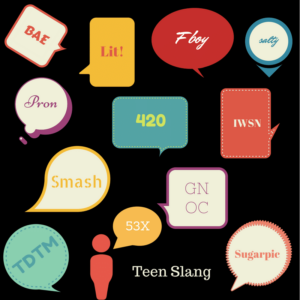
Two weeks ago Access Hollywood Live asked me to appear on a parenting segment to discuss slang kids and teens use online. I accepted the request planning to discuss the reasons teens use slang and offer suggestions to parents about how to respond when they see social media slanguage. Very quickly I realized I don’t have “expertise” about current slang terms. My teens and those I interact with in my office don’t talk or text slang with me, leaving me in the dark like every other parent. So I reached out to the teens themselves. Not only did my informal survey generate a list of popular slanguage that parents should be familiar with, but I also learned that teens are having less sex despite our fears.
Why teens use slang
During the adolescent developmental period, teens are creating their own identities independent from their parents. Developing peer relationship skills prepares them to better select a mate later on. At this point in their development, they’ve mastered attachment to mom and dad; now it’s time to learn how to select quality friends, maintain healthy friendships, and form a community with peers. In order to form community, one must create a culture of shared identity and ideals. That means creating similar passions, fashions, music, and language among one’s chosen peer group. Hashing out leadership and alliances are centeral issues behind teen drama. What better way to investigate the complexities of peer interaction than through observation?
Celebrity culture and its impact on slang
Ever wondered why kids are so enamored with the reality show format of Keeping Up With the Kardassians? It’s because they’re trying to keep up with the Kardassians! The sisters in this family are hip, rich, and glamorous. Unlike the typically uptight parents, television celebrities (and their producers) know how to offer up issues kids are most concerned about like beauty, parties, and sex appeal.
Watch the reality shows your kids watch, and you’ll recognize that they are an entertaining forum to learn about forming friendships, negotiating conflict, making yourself appealing to others, and getting rich. Each scuffle between beautiful sisters is a lesson in getting one’s needs met while maintaining connection with those you love. Whether we like it or not, our teens are driven to learn how to “be” from those they admire. Learning from television is particularly prominent as our families get smaller, our houses get larger, and we spend more hours watching screens and less time with each other. No longer do kids listen in on the conversations of their extended family members as they cook in the kitchen or sit on the porch. Now they watch unscripted (but certainly produced) reality television shows to learn how to behave in a group. We protect them by keeping teens home, which can create loneliness and, arguably, less resilience overall.
How is slang different today than when we were young?
Teens from every generation have their own slang, but what today’s kids have that we didn’t is online interaction and less face-to-face interaction.
3 Ways Online Slang Differs From Offline Slang
IMMERSION: No longer is teen social time limited by face-to-face opportunity. Now kids bond with texting and social media most of their waking hours. This means their online relationships are often more intimate and all-consuming than their offline relationships.
IMPACT: When kids post, their content may reach hundreds, thousands, or millions. The more “likes” for their image or post, the more reinforcement. That means kids customize content for shareability and impact. The language used while attaching to teen peers is more intense, shocking, and emotive, reflective of romance and hormone-driven drama.
INHIBITION: Without seeing your words register on somebody’s face, teens are bolder with their sexuality and aggression. Cyberbullying is rampant and edgy commentary is commonplace.

What do parents need to know about teen slanguage online?
When I asked teens what parents need to know, they resoundingly responded, “nothing!” Their intent is to create a culture distinct from moms and dads. As soon as parents understand and, God forbid, use teen slang, it is immediately retired (just like social media apps when parents take over).
There are different types of slang. Spoken slang is designed for humor and impact, emoji slang is designed for simplicity of concept, and abbreviation slang is created for efficiency and sometimes secrecy. Abbreviation slang is likely the most dangerous in that it may be a way for an online predator to extend challenges and invitations to naïve targets. The teens I spoke to insisted those terms are not commonplace.
Has the vulgar online culture resulted in teens having more sex?
When Hollywood Access Live host Natalie Morales asked me, “Now our kids are using code language. Often times it’s harmless and other times it’s not, right?” I responded, “I don’t think teens are any scarier today than we were.” Amidst good-natured laughter, Natalie protested saying, “I think they’re a little more promiscuous than we were.” Guest host Garcelle Beauvais added, “We feared our parents, I don’t think our kids fear us.” Then we went on to agree that online teen online language is far more explicit and vulgar than the slang of yesteryear.
But here is what you may be surprised to learn: even though today’s teens demonstrate more acceptance of casual and what we used to consider deviant sexual practices (like oral sex, anal sex, same gender sex, and polyamory), teens are more sexually responsible than previous generations. In fact, despite popular misconceptions that teens are hooking up casually, the truth is they are “talking” more than dating and having sex later and with fewer partners than previous generations. They are also more likely to use contraception, resulting in teen pregnancy rates being at an all-time low. Shocking right?
A 2016 survey, conducted by the Centers for Disease Control and Prevention of 16,000 9 – 12th grade students from 125 public and private schools, found marked declines in the percentage of kids having sex, a later age for first intercourse, and fewer partners than the teens of previous generations. The drop is sharpest for ninth-graders, showing a dramatic 40% drop in the number of sexually active teens since 1991 (Twenge, 2017). The today’s average teen has their first sexual intercourse during spring of 11th grade, a full year later than the generation before them. This led researchers to conjecture that fewer teen pregnancies and abortion wasn’t just because of better use of birth control, but because of less sexual intercourse.
Why? Nobody can be sure, but it makes sense that kids have less opportunity than ever before. Look in your own home. Are your teens running around the neighborhood with other teens until the streetlights come on? Not so much, right? Instead they are home watching videos, texting, and using social media on average of 10 hours a day. Screen use has so dramatically changed adolescence that 12th-graders in 2015 go out less often than eighth-graders did in 2009 (Twenge, 2017). Kids staying home on screens rather than interacting in the community without parents has resulted in benefits and risks.
Author Dr. Jean Twenge reports that teens are physically safer than they’ve ever been. Kids today are less likely to drink alcohol, smoke cigarettes, or get in a car accidents than teens from previous generations. In fact, one in four teens will not have gotten their driver’s license upon graduating high school, a dramatic change from previous generations who were at the DMV the day they turned 16. Teens are also not employed like previous generations (from 77% among high school seniors in the 1970s to 55% today). With academic and athletic pressures, parents are more accepting of teen leisure time. But does more leisure mean better mental health?
No, rates of teen depression and suicide have skyrocketed since 2011. With increased screen time, teens get less sleep and report more unhappiness and loneliness. Social media doesn’t make them feel more connected, it makes teens feel more left out (Twenge, 2017). Microaggressions online are constant and cyberbullying has chronic impact. Viewing thousands of altered beauty images daily gives rise to body image distortion and anxiety. Online activities fill time and can be fun, but at the end of the day a chronic sense of loneliness and dissatisfaction has its cost. Some have even called it a mental health crisis. The dramatic changes in childhood within the last ten years due to screen use among kids and teens in my practice are the reason I founded GetKidsInternetSafe.
What can we do?
We can limit screen time and enrich their lives by encouraging healthy relationships. We can optimize the benefit of education through digital literacy, recognizing that there are screen activities that provide important health information. Then follow up this information by talking to them about our values and belief systems. Protecting them too much can reduce resilience. But supporting healthy independence and staying present for them increases resilience. Monitor their slang and invite discussion, but don’t bury your head or get intrusive.
Below is a quick list of the most common slang offered up by the teens in my community. My best tip for decoding your teen’s most recent linguistic masterpiece is to look it up on the site Urban Dictionary. If you do use this source, be prepared to be shocked. It is user created, and contributors hold nothing back. Profanity and sexuality is blatant. Be brave. The more you know, the more credibility you’ll have during important family discussions. What do you think? Are kids scarier now than we were? Let me know what you think in the comments below.
Do you wonder if teen slang is contributing to the hookup culture? Check out the article, Is Your Teen Hooking Up? for ideas about how to support your kids in today’s casual sex environment.
I’m the mom psychologist who helps you GetKidsInternetSafe.
Onward to More Awesome Parenting,
Dr. Tracy Bennett
The GKIS Quicklist of Current Teen Slanguage
FOR TEXT:
53X: Sex
8: Oral sex
9: Parent watching
CD9: Parents around/Code 9
99: Parent gone
1174: Party meeting place
420: Marijuana
GNOC: get naked on camera
CU46: see you for sex
LMIRL: let’s meet in real life
IWSN: I want sex now
IKR: I know right
TLDR: too long didn’t read
IMO: in my opinion
FFS: for f*&k sake
NIFOC: Naked in front of computer
PIR: Parent in room
POS: Parent over shoulder
KOTL: Kiss on the lips
PRON: Porn
TDTM: Talk dirty to me
IPN: I’m posting naked
LH6: Let’s have sex
WTTP: Want to trade pictures?
DOC: Drug of choice
TWD: Texting while driving
GYPO: Get your pants off
KPC: Keeping parents clueless
AMA: Ask Me Anything
THOT: That hoe over there
CID: Acid (the drug)
DAE: Does Anyone Else?
Dafuq: (What) the f***?
DM: Direct Message
ELI5: Explain Like I’m 5 (my Fav!)
FML: F*** My Life
FTFY: Fixed That For You
CONVERSATIONAL SLANG:
Broken: Hungover from alcohol
SugarPic: Suggestive or erotic photo
Thirsty: craving attention, desperate
Turnt: to be wasted or crazy
Bae/boo: my girl/boyfriend (before all else)
Smash: do have sex with somebody
F boy: male slut
Tweekin: worried
Skrt: to get out of talking to someone “I need to skrt”
Lit: really cool or wasted
Af: as f&^k
Goat: greatest of all times
Shook: can’t believe it
Thick: someone who is very curvy
Salty: upset or bitter
Extra: over the top dramatic
Savage: cruel
Woke: with it or knowledgable
Shade: untrustworthy
Gucci: cool or I agree
Cash me outside: let’s fight
That’s fire: that’s really good
Dope: that’s cool or good
Yee: hyped up about something fun
Dank: that’s cool or good
Savage: cruel
Choice: fly, desirable, the best
Idek: I don’t even know
Boosted: a league of legends term for a bad player who paid to get a higher rank (a poser)
Fleek: cool
Sources Cited
https://www.cdc.gov/mmwr/volumes/65/ss/pdfs/ss6509.pdf
https://www.theatlantic.com/amp/article/534198/
Don't worry, we will never spam you.









